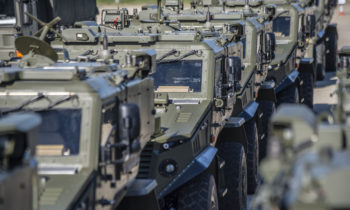
A group of foxhounds line up in the vehicle park before the road move starts.
Exercise TRIDENT JUNCTURE 2018 (TRJE) is the largest in a series of long-planned military exercises to ensure that NATO forces are trained, able to operate together and ready to respond to any threat, from any direction. Over 30 nations, involving 40,000 personnel are taking part in this 6 week exercise.
The British ArmyÕs 4th Infantry Brigade HQ will deploy to command UK Reconnaissance, Infantry, Combat and Logistic Support units alongside a Danish battlegroup and a Polish Mechanised Infantry Company.
The main British Army units will consist of The Light Dragoons, 1st Battalion The Royal Irish Regiment, 1st Battalion The Duke of Lancaster Regiment and 102 and 104 Logistic Brigade.
Ex TRJE 18 consists of 4 elements
¥ Deployment & Redeployment Ð The British Army will move 1600 soldiers and over 1000 vehicles and equipment over 2500kms by road, rail, sea and airfrom the UK across Northern Europe and into Norway.
¥ NATO alliance and international training.
¥ Main exercise (Livex)
¥ Command Post exercise.
Photographer:
Corporal Ben Beale/ MoD Crown
UK troops landed at Rotterdam in the Netherlands on Wednesday (10 October 2018) as German tanks boarded a cargo ship on their way to Norway for Exercise Trident Juncture 2018 – NATO’s largest since the Cold War.
Over the next few days, 70 Foxhound, Husky and Landrover vehicles will make the 2,000km journey from the Hook of Holland harbour through northern Europe to Norway. The UK convoy’s move through the Netherlands, Germany, Denmark and Sweden will test how efficiently soldiers and equipment can move between European countries. It will also test customs, border regulations and infrastructure’s ability to cope with rapid and heavy troop movements.
As UK troops make their way through northern Europe, the German army is shipping Leopard tanks and other military vehicles onboard a civilian cargo ferry from the northern German town of Emden to Fredrikstad, Norway where they are scheduled to arrive on Thursday (11 October).
“Military mobility is vital, especially to reinforce in a crisis. That’s exactly why we exercise it,” said NATO spokesperson Oana Lungescu. “Over the past few years, NATO has made real progress in improving our ability to deploy troops quickly across Europe. We are overcoming legal hurdles and cutting red tape, including by working closely with the European Union. Looking ahead, we aim to further reduce border-crossing times (clearances within five days by the end of 2019), identify alternative supply routes, and exercise even more to practice military mobility,” she added.
Around 50,000 troops and 10,000 vehicles from all 29 NATO countries, as well as Sweden and Finland, will come together for the Trident Juncture exercise, which starts in Norway on 25 October.
(NATO)
